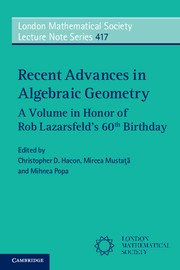Book contents
- Frontmatter
- Contents
- List of contributors
- Preface
- 1 The effect of points fattening in dimension three
- 2 Some remarks on surface moduli and determinants
- 3 Valuation spaces and multiplier ideals on singular varieties
- 4 Line arrangements modeling curves of high degree: Equations, syzygies, and secants
- 5 Rationally connected manifolds and semipositivity of the Ricci curvature
- 6 Subcanonical graded rings which are not Cohen–Macaulay
- 7 Threefold divisorial contractions to singularities of cE type
- 8 Special prime Fano fourfolds of degree 10 and index 2
- 9 Configuration spaces of complex and real spheres
- 10 Twenty points in ℙ3
- 11 The Betti table of a high-degree curve is asymptotically pure
- 12 Partial positivity: Geometry and cohomology of q-ample line bundles
- 13 Generic vanishing fails for singular varieties and in characteristic p > 0
- 14 Deformations of elliptic Calabi–Yau manifolds
- 15 Derived equivalence and non-vanishing loci II
- 16 The automorphism groups of Enriques surfaces covered by symmetric quartic surfaces
- 17 Lower-order asymptotics for Szegö and Toeplitz kernels under Hamiltonian circle actions
- 18 Gaussian maps and generic vanishing I: Subvarieties of abelian varieties
- 19 Torsion points on cohomology support loci: From D-modules to Simpson's theorem
- 20 Rational equivalence of 0-cycles on K3 surfaces and conjectures of Huybrechts and O'Grady
- References
1 - The effect of points fattening in dimension three
Published online by Cambridge University Press: 05 January 2015
- Frontmatter
- Contents
- List of contributors
- Preface
- 1 The effect of points fattening in dimension three
- 2 Some remarks on surface moduli and determinants
- 3 Valuation spaces and multiplier ideals on singular varieties
- 4 Line arrangements modeling curves of high degree: Equations, syzygies, and secants
- 5 Rationally connected manifolds and semipositivity of the Ricci curvature
- 6 Subcanonical graded rings which are not Cohen–Macaulay
- 7 Threefold divisorial contractions to singularities of cE type
- 8 Special prime Fano fourfolds of degree 10 and index 2
- 9 Configuration spaces of complex and real spheres
- 10 Twenty points in ℙ3
- 11 The Betti table of a high-degree curve is asymptotically pure
- 12 Partial positivity: Geometry and cohomology of q-ample line bundles
- 13 Generic vanishing fails for singular varieties and in characteristic p > 0
- 14 Deformations of elliptic Calabi–Yau manifolds
- 15 Derived equivalence and non-vanishing loci II
- 16 The automorphism groups of Enriques surfaces covered by symmetric quartic surfaces
- 17 Lower-order asymptotics for Szegö and Toeplitz kernels under Hamiltonian circle actions
- 18 Gaussian maps and generic vanishing I: Subvarieties of abelian varieties
- 19 Torsion points on cohomology support loci: From D-modules to Simpson's theorem
- 20 Rational equivalence of 0-cycles on K3 surfaces and conjectures of Huybrechts and O'Grady
- References
Summary
Abstract
There has recently been increased interest in understanding the relationship between the symbolic powers of an ideal and the geometric properties of the corresponding variety. While a number of results are available for the two-dimensional case, higher dimensions are largely unexplored. In the present paper we study a natural conjecture arising from a result by Bocci and Chiantini. As a first step toward understanding the higher-dimensional picture, we show that this conjecture is true in dimension three. Also, we provide examples showing that the hypotheses of the conjecture may not be weakened.
Dedicated to Robert Lazarsfeld on the occasion of his sixtieth birthday
1 Introduction
The study of the effect of points fattening was initiated by Bocci and Chiantini [3]. Roughly speaking, they considered the radical ideal I of a finite set Z of points in the projective plane, its second symbolic power I(2), and deduced from the comparison of algebraic invariants of these two ideals various geometric properties of the set Z. Along these lines, Dumnicki et al. [7] studied higher symbolic powers of I. Similar problems were studied in [1] in the bi-homogeneous setting of ideals defining finite sets of points in ℙ1 × ℙ1.
It is a natural task to try to generalize the result of Bocci and Chiantini [3, Theorem 1.1] to the higher-dimensional setting. Denoting by α (I) the initial degree of a homogeneous ideal I, i.e., the least degree k such that (I)k ≠ 0, a natural generalization reads as follows:
Conjecture 1.1Let Z be a finite set of points in projective space ℙn and let I be the radical ideal defining Z. If
d := α (I(n)) = α(I) + n − 1,
then either
α(I) = 1, i.e., Z is contained in a single hyperplane H in ℙn
or
Z consists of all intersection points (i.e., points where n hyperplanes meet) of a general configuration of d hyperplanes in ℙn, i.e., Z is a star configuration. For any polynomial in I(n) of degree d, the corresponding hypersurface decomposes into d such hyperplanes.
- Type
- Chapter
- Information
- Recent Advances in Algebraic GeometryA Volume in Honor of Rob Lazarsfeld’s 60th Birthday, pp. 1 - 12Publisher: Cambridge University PressPrint publication year: 2015
References
- 3
- Cited by



